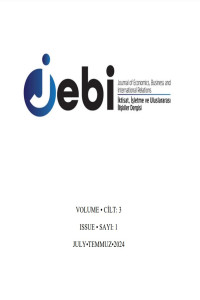Research Articles
Issue Reviewers






Aim & Scope
This journal aims to publish research articles that can contribute to theory and practice in the field of business administration. For this purpose, efforts are made to contribute to the development of science by evaluating studies in the field, especially the national literature, fairly and accurately.
Turkish and English articles in the field of business administration are accepted in our journal. In this context, publications are made within the scope of qualitative and quantitative research articles on subjects of national and international importance. Research in the fields of Management, Organizational Theories, Organizational Behavior, Strategy, Human Resources Management, Finance and Accounting constitutes the scope of the journal.
Author Guidelines
Journal writing rules are presented below and click for sample text.
English and Turkish articles are accepted in the journal. Authors whose articles are accepted must sign a copyright transfer form and send it to the editorial board. Authors take responsibility for all statements in the work they submit to the journal for publication. The studies to be sent to the journal should be prepared as follows:
1. Font
All text should be written in Times New Romans font, 12 points and 1.5 line spacing. The "tab" key should not be used at the beginning of the paragraph.
2. Page Layout
The works should be prepared on one side of the A4 size paper, leaving 2.5 cm margins from the top, bottom, right and left sides. In addition, the number of pages, including the abstract and the bibliography, should not exceed 40 and the page numbers should be in the lower right corner of the page.
3. Author Information
The names of the author/authors should be given just below the title of the study, adjacent to the right. In addition, the title, institution, e-mail address and ORCID ID of the author should be indicated in the footnote at the bottom of the page in the form of an asterisk (*).
4. Title and Essence
The following table should be considered according to the working language. Abstracts in the study should not exceed 250 words each. The aim, scope, method information and basic findings of the study should be briefly mentioned in the abstract. At least 3 and at most 5 keywords should be given under the abstract.
Working Language
Queue English Turkish
Article Title 1. English title (13.5pt)
2. Turkish title (12pt) (optional)
2. English title (12pt) 1. Turkish title (13.5pt)
2. English title (12pt)
Abstract 1. English abstract (9pt)
2. Turkish abstract (9pt) (optional)
2. English abstract (9pt) 1. Turkish abstract (9pt)
2. English abstract (9pt)
5. Main Text
Basically, the title(s), abstract(s) and keywords, main text sections, bibliography and if necessary appendices should be included in the studies. For articles whose working language is Turkish, an English Extended Abstract should be added to the text.
6. Tables and Figures
All images, graphs and figures should be named "Figure" and tables should be named "Table". Tables and figures should be numbered and presented with an explanatory title. The titles of the tables should be at the top and the titles of the figures should be at the bottom.
Examples: Table 1: Demographic Characteristics / Figure 1: Conceptual Model
Figures should be in high resolution and black and white colors should be used in the figures. Vertical lines should not be used in tables. Horizontal lines should only be used to separate subheadings in the table. The size of tables and figures should not exceed the page limits. Decimal numbers used in tables should be given with two digits after the comma.
7. Appendices
Appendices should be given at the end of the text after the bibliography.
8. Citations and Citations
Authors should use version 6 of the APA (American Psychological Association) citation style for in-text citation and citation. References should be indicated in the text by writing the surnames of the authors and the date of publication in parentheses. If more than one source is to be cited in the text, the (;) sign should be used between the references.
Authors should make sure that in-text citations are shown in the references section, the cited dates and author names should be the same in the text and in the references section.
Examples of in-text citations are as follows:
Zimmerman (1983)
(Bloomfield & Anderson, 2010)
Chen et al. (2010: 122)
(Gneezy, Niederle, & Rustichini, 2003; Gneezy & Rustichini, 2004).
(Post et al., 2008)
9. References
For references in articles, version 6 of the APA (American Psychological Association) reference style should be followed (https://apastyle.apa.org/). References should be given in the bibliography section in alphabetical order and in 11 font size. If more than one study by the same author is cited, these studies should be listed from oldest to newest. If the name of the author is not known, the name of the scientific study should be written instead of the author's name. The second and subsequent lines of the reference section should be adjusted to start 1 cm inside.
The following is an example of the notation in the references section:
Almeida, H., Campello, M., & Weisbach, M. S. (2004). The cash flow sensitivity of cash. Journal of Finance, 59(4), 1777–1804.
Bao, D., Chan, K. C., & Zhang, W. (2012). Asymmetric cash flow sensitivity of cash holdings. Journal of Corporate Finance, 18, 690–700. https://doi.org/10.1016/j.jcorpfin.2012.05.003.
Calfee, R. C., & Valencia, R. R. (1991). APA guide to preparing manuscripts for journal publication. Washington, DC: American Psychological Association.
Chen, D., Gan. C., Hu, B. (2013). An empirical study of mutual funds performance in China. Retrieved fro
Ethical Principles and Publication Policy
Publication Ethics
This journal is committed to applying the highest level of scientific publication ethics. The journal is based on the principles of basic practices prepared in accordance with the guidelines and policies developed by the Committee on Publication Ethics (COPE) for journal editors. The journal references publication ethics flowcharts (https://publicationethics.org/resources/flowcharts) developed by COPE in cases of abuse or violation of publication ethics.
Articles published in the journal go through a double-blind peer-review process.
All submitted articles must be original, unpublished, and not in the process of being evaluated in another journal. The author must declare that the article is original, has not been published elsewhere, and is not under consideration for publication elsewhere, in another language.
Applicable copyright laws and agreements must be observed. Copyrighted material (for example, tables, figures, or large quotations) should be used with due permission and acknowledgment.
The sources used in the article should be used appropriately and should be cited in the references. Each article is double-blindly evaluated by at least two referees. Plagiarism (plagiarism), forgery, duplication, research slicing, wrongful authorship, copyright infringement, and concealment of a conflict of interest are considered unethical behaviors. Articles that do not comply with accepted ethical standards are not accepted for publication.
Licensing
This license permits users to distribute, rearrange, adapt and create material in any medium or form, solely for non-commercial purposes and only as long as attribution is made to the creator. (https://creativecommons.org/licenses/by-nc/4.0/deed.tr)
You are free to do these:
Share — you can copy and redistribute the work in any medium or format.
Adapt — mix, transfer and build on existing work
As long as you fulfill the license terms, the licensee cannot revoke these freedoms (the rights stated).
Under the following conditions:
Attribution — you must provide appropriate reference, link to the license, and notify if changes have been made. You may do so appropriately, but this does not imply that the licensee approves of you and your use.
Non-Commercial — You may not use this material for commercial purposes.
No additional restrictions — You may not impose any legal terms or technological measures that would lawfully restrict the use of the permissions provided by the license.
Research Ethics
Journal of Business Research observes the highest standards in research ethics and adopts the international research ethics principles defined below. The compliance of the articles with the ethical rules is the responsibility of the authors.
Principles of integrity, quality and transparency should be ensured in designing the research, reviewing the design, and conducting the research.
The research team and participants, the purpose of the research, its methods and possible uses; should be fully informed about the necessities and risks, if any, of participating in the research.
Confidentiality of information provided by research participants and confidentiality of respondents should be ensured. Research should be designed in a way that preserves the autonomy and dignity of the participants.
Research participants should take part in the research voluntarily and should not be under any coercion.
Harm to the participants should be avoided. The research should be planned in such a way that it does not put the participants at risk.
Be clear about research independence; If there is a conflict of interest, it should be stated.
In experimental studies with human subjects, written informed consent must be obtained from participants who decide to participate in the research. The consent of the legal guardian of children and custodians or those with a confirmed mental illness must be obtained.
If the study will be carried out in any institution or organization, approval must be obtained from that institution or organization.
In studies with a human element, it should be stated in the “methods” section that “informed consent” was obtained from the participants and ethics committee approval was obtained from the institution where the study was conducted.
Authors Responsibility
Compliance of the articles with scientific and ethical rules is the responsibility of the authors. The author must declare that the article is original, has not been published elsewhere, and is not under consideration for publication elsewhere, in another language. Applicable copyright laws and agreements must be observed. Copyrighted material (for example, tables, figures, or large quotations) should be used with due permission and acknowledgment. The sources used should be used appropriately and should be cited in references.
All authors must have a direct academic and scientific contribution to the submitted article, in this context, an “author” is a person who makes a significant contribution to the conceptualization and design of a published research, to the acquisition, analysis or interpretation of data.
Price Policy
In this journal, no fee is charged from the authors during or after the application.
In addition, there is no charge for accessing the journal.
In this journal all articles are published Open Access.


